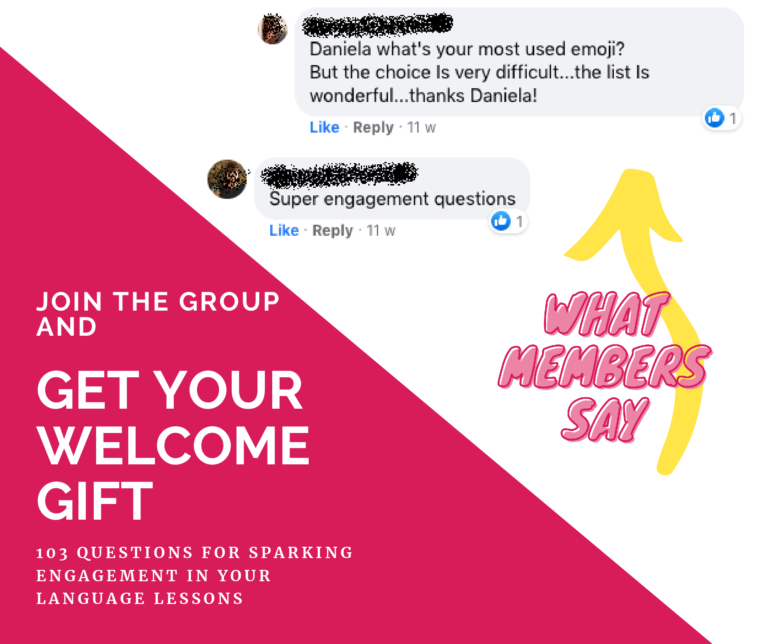
Isn’t it frustrating when you spend hours planning foreign language lessons supposed to get your students to speak and engaged, but what you get in return is… crickets? Don’t worry, these strategies for teaching speaking skills come to the rescue!
I mean, silence and reluctant students’ faces staring at you. What you planned was a language lesson where the interaction flows smoothly. What you actually get is students trying to hide themselves behind grammar acquisition and structured grammar exercises.
Well, there is something you can do about this. In this article you are going to learn about the 5 strategies for getting your students to speak and engaged in your English lessons, French lessons, Spanish lessons, any-language lessons. These are strategies for teaching speaking skills that work regardless of the target language you teach.
Now, you might know the approach I propose is based upon drama. Despite of what many teachers might expect from this blog post, I’m not going to teach you the five drama-based strategies for getting your students engaged. Why? Because drama approaches for language teaching require a solid and safe learning environment in order to be effective. In other words, if you think your students don’t speak enough, jumping straight into drama might be too much for your students. They might not be ready for such type of work in class. Whether you have never got into language teaching through drama or you are an expert language and drama teacher, these basic strategies will help you to reach the goal.
“If you think your students don’t speak enough, jumping straight into drama might be too much for your students.”
Why are these five strategies for teaching speaking skills the perfect starting point?
I picked these five strategies among all the tactics and tips I usually give in my teachers training courses. Specifically, I selected those five out of many others because:
- they are easy to be implemented
- they work at different levels of the relationship with the students
- they can be applied in in-person lessons as well as online lessons
- they are bulletproof. I mean, if you mess up a bit with them (you might not implement them by the book at the beginning), you won’t worse the situation. On the contrary, you will learn something more about what to do and what to avoid. Pinky promise!
What’s the purpose of the five strategies for teaching speaking skills?
The strategies for teaching speaking skills have two purposes: 1) to get quick wins and immediate results when it comes to getting language students to speak and getting them engaged; 2) to prepare the ground for more intense drama-based work.
The five strategies answer three hot questions:
- How do I pitch the topics I need to introduce to my students?
- How do I encourage my students to speak and to interact?
- How do I keep my students engaged until the last minute of my lessons?
Below you are going to learn what the strategies for teaching speaking skills are, how they work and why they are so important to be implemented (looking at the methodological principles).
In addition to what you are about to read, I invite you to download the FREE guide for at least three reasons:
- To get practical tips and ideas for implementing each strategy
- To keep the content of this article at hand, while you are planning the next courses or during your lessons
- To take the first step in putting the strategies into action. In the free guide you will find an Action Plan for helping you to spot a starting point and get the change started.
Good news: the strategies I’m sharing with you are suitable for an audience of adult students as well as for younger students and children.
The top five strategies explained
The top five strategies for getting language students to speak are:
- Pitch topics through open-ended questions
- Tap into shared experiences
- Take care of the learning environment
- Encourage attempts to enable them to feel safe
- Invite them to enable them to feel free.
Let’s have a closer look at each one.
“Meaningful learning taps into students’ experience.”
Create movement through questions
At the beginning of a lesson we usually pitch the topics we want to introduce to our students in order to trigger curiosity and to start a conversation. We can do that by asking questions. It is important to know what type of questions create movement in the group, though. Closed-ended questions open up one type of answer, yes or no. For example: “Do you like holidays?”. We want to avoid closed-ended questions because they don’t create movement in the group. Instead of closed-ended questions, try to pitch a topic through open-ended questions, for instance: “What is your favourite place for holidays?”. Open-ended questions open up options for carrying out conversations and, most importantly, enable us to tap into the students’ experience. For instance:
Teacher – “Today we are going to learn about holidays. What is your favourite place for holidays?”
Students – “I like going to the mountains.” “I live the coast.” “I prefer visiting cities”…
Teacher – “Why?” “Have you been there recently?” “What do you like to do when you are there?”. And so on.
Open-ended questions trigger reflection and create opportunities for getting the conversation to flow.
“All new knowledge is built upon existing knowledge.” J. Zull
Create shared experiences
Tapping into our students’ personal experience is often the best way to introduce new topics. When students don’t have an experience linked to the content you want to introduce, you can create a shared experience through a simulation game. You will then debrief the game bringing out all keywords and key phrases the students know and put into use in the game as well as keywords and key phrases they don’t know and need to learn.
Tapping into the students’ personal experience makes learning relevant to them. If there isn’t a shared experience, we shall create it in class.
Let your students know they are welcome and that you care
Getting the training room settled before the students arrive is a great way to make them feel welcome and safe. By taking care of the training room you show your students they are important to you, you really care. Creating a welcoming and safe environment encourages sharing. The good news is that this can be achieved by implementing small changes and by taking care of small things. For example, you might bring in the training room something to decorate the room and make it look nicer. This applies to online lessons, too. Ask yourself: how could I improve the online experience of my students? Can I make it easier for them to get online and to deal with the online tools? The free guide will give you some ideas about this.
One of the toughest learning barriers we, language teachers, have to overcome is the emotional barrier. According to the suggestopedic framework, feeling uncomfortable, anxious, scared or inadequate, are all experiences that trigger the emotional barrier. By welcoming our students and showing we care, we help them to feel safe and at the right place. This means they will be probably more willing to speak up.
Encourage attempts
You probably heard about this millions of times, but it’s worth it repeating it: mistakes are the proof your students are learning. Nice quote. Now, let me give you a tip on what to do with that fancy quote, from a practical point of view. If you take mistakes as attempts to achieve a result, you don’t want to boycott those attempts, right? As a consequence, avoid to directly intervene to correct your students’ mistakes. Instead, reframe what they said by repeating it in the correct form. For example: Student – “I go to the cinema yesterday.” You – “How interesting! I went to the cinema yesterday, too.” The interaction should flow like a normal conversation.
This simple strategy can make the whole difference, believe me. Back to the emotional barrier mentioned in strategy #3, when you are able to make your students feel safe in the words they speak and never, never ever, judged for what they say and how they say it, then you are helping them to overcome their emotional barrier.
Georgi Lozanov, father of Suggestopedia, used to compare this specific teaching approach to the behaviour of any mother who teaches her little one to ride a bicycle: she is supportive and she is encouraging towards the attempts of her little girl, without judging her for what she can’t do yet. On the contrary, she acknowledges even the smallest progress.
The free guide will give you a few ideas on how exactly to implement this approach to ‘mistakes’.
Invite your students to join in
When students feel free to join in an activity or to refuse to participate, that is the first step into building a trustful relationship with them. Trust is the conditio sine qua non for engagement. Believe me. Rather than giving instructions and deciding who has to do an exercise, try to invite your students to join in. Be patient and respectful to those students who don’t want to take part in the activities yet. It won’t happen all at once, but I promise everybody will join in at some point. The key-phrase here is ‘Would you like…?’. For instance: ‘Would you like to take a turn in the role-play?’.
Another principle belonging to the suggestopedic framework is called freedom. In Suggestopedia, by freedom we mean the students have to feel anytime free to join in or not, to open up to the learning experience rather than to stay apart. The acquisition process becomes effective when it is the reflection of the individuals’ spontaneous and free will.
Want to implement the strategies for teaching speaking skills presented above? Take action now and download the free guide!
What to start with?
Don’t let all this fall into an empty box. My invite is to take action and test the strategies out. At the beginning, it could be overwhelming. That’s why I always suggest the teachers I train to start from one strategy and to pick one tactic (tip, idea) within that strategy. Afterwards, practice makes perfect!
Because I love the easy peasy lemon squeezy type-of-approach, I prepared a mini Action Plan for you to help you to break the ice.
Enjoy it!
Want more support?
Join the Facebook group Independent Language Teachers Collective to get daily advice, tons of free training and to branch out with other independent language teachers like you!
ALSO…
Available only for the Collective members: free list 103 question for sparking engagement in your language lessons.
This is what members say about the freebie:

Join in the Collective and grab your welcome gift:
Join Facebook Group

